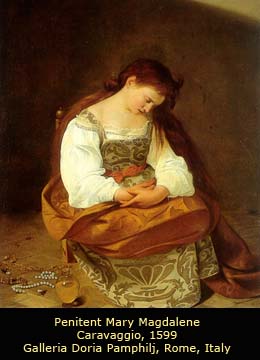Mary Magdalene: Saint or Sinner?
Caravaggio, 1599
Palazzo Doria Pamphlij, Rome, Italy
Mary Magdalene, the woman who knew the all of Jesus, is in fact one of the most depicted of all classical figures. She is frequently portrayed with jewellery and a mirror, or sitting at the dressing table, or in solitude of a wilderness grotto, or as a saint with candle and book, or as a sinner with jar of ointment, or as a excellence of woman's beauty, or as a woman devoted to Jesus. All these objects, jewellery, candles, books, jar of ointments, and grottos, make her personality distinctive, especially when she is seen in the company of other woman. Mirror and jewellery were introduced to symbolize Mary's renouncement of earthly vanities, the candle and the book represent the importance of light and knowledge, the skull is synonymous of death, the rocks symbolize Christ, and jar of ointment remains the Gospel event, when Mary Magdalene anointed the head and feet of Jesus at the House of Simon, shortly before the Crucifixion. Looking at a thousands of individual representations of Mary Magdalene, it is interesting to notice that the alabaster ointment jar became her most constant symbol of recognition. It has been used by artists in whatever circumstances of her imaginary portrayal.
There are also numerous portrayals of her depicting her at the cross, at the tomb or as a company of Jesus. The great majority of these depictions are related to recognizable Gospel events, but many of them have nothing to do with any of events related in New Testament. In fact, the scenes where she appears surrounded by jevellery and mirror, sitting and dressing table or her images of Penitent or Repentant Magdalene are quite unrelated to any of her appearance in Bible or New Testament.
The scenes that depicts Mary Magdalene in thousands of individual representations in visual art, in general, can be classified as biblical: "Christ appearing to Mary Magdalene (Noli me tangere) after Resurrection", " Christ and Mary Magdalene", "At the Foot of the Cross", "At the tomb", "Lamentation" "At the house of Simon", "The alabaster jar" "Jesus at the house of Martha" and not biblical: "Penitent and Repentant Magdalene", "Madonna and Child with Mary Magdalene", "Mary Magdalene in Grotto", "Assumption of Mary Magdalene", "Mary Magdalene in Provence", "Mary Magdalene with angels",. There are also some alternative classifications, often allegorical, but in essence they are included in the general one, above.
Through centuries Mary Magdalene was considered one of the most accessible saints, offering hope of transformation from sinner to saint. Her legend is a conflation of numerous scriptural references and apocryphal stories. She was the woman who was purified and pardoned by Christ. She was also a woman who was present at the Crucifixion, and was the first person to whom Christ appeared after his Resurrection (Mark 16:9). And she was the one whom "Christ loved more than all the disciples"
This a truly astonishing picture commissioned to Caravaggio by Monsignor Petriganini in 1595, portrays the repentant Mary Magdalene, as a young pretty girl sitting on a stunted chair that seems to sink into the floor in the middle of the very bare room. Her head with near classical profiling seems to prefigure the perfect woman profile of Guido Reni. She is not a saint yet. In fact she does not even have a halo, but the light of Salvation, exemplified in the top part of the painting by a shaft of light, shines on the repented sinner, redeeming her. On the floor at her feet lies the abandoned jewellery - a string of pearls, small pearl earrings with the black bow, golden chain ended with a tassel, and a jar precious ointment with which she used to anointed the feet of loved Lord. Her loose dark reddish hair are flowing softly down on her shoulders. Her rich costume consists of a white-sleeved blouse, a light brown tunic and a flowery skirt. The sadness expression on her beautiful face, the teardrops on her cheek and her silent sobbing, all together make a sad feeling of sweet abandonment. She is not crying for her luxury past life, but for the sweet embrace of her Lord. In this stunning portrait the nursing pose of her body suggest pregnancy of Mary Magdalene. The red bow of her dress makes her gravity more apparent. The scene would not be completed without detection of the shell designed chalice on the very front of her skirt. According to tradition shell was the powerful attribute of goddess of earthly love and was a symbol of fertility. In this simple way Caravaggio associated Mary Magdalene to Aphrodite, goddess of earthly love and patron of pregnant women.
We do not know how Monsignor Petrignani accepted this stunning, although very naturalistic portrayal of a pretty girl. We can speculate that straight forward Monsignor Pertignani could not appreciate Caravaggio's complicated nature. Caravaggio's taste for dirty feet and grimy finger nails of prostitutes and adolescent youths does not correspond to the church classics and its conventional preference for idealized forms. Our presuppositions seem to confirm also the fact that the early eighteenth-century inventory of palazzo Doria Pamphilj mentioned the portrait of Mary Magdalene in the golden frame with Aldobrandini coat of arms that matches to our description.
